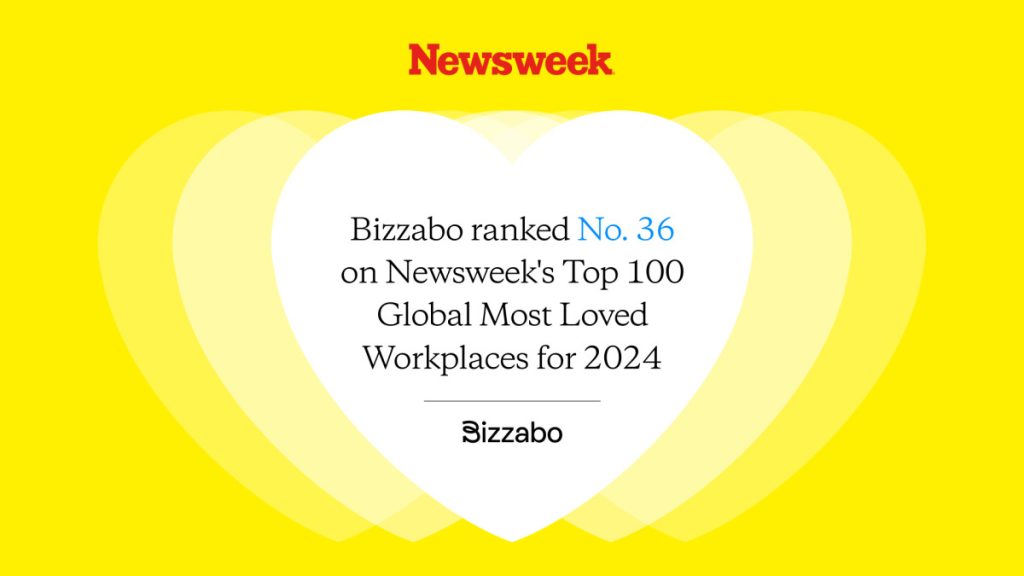The Complete Guide to Audience Engagement in the Events Industry

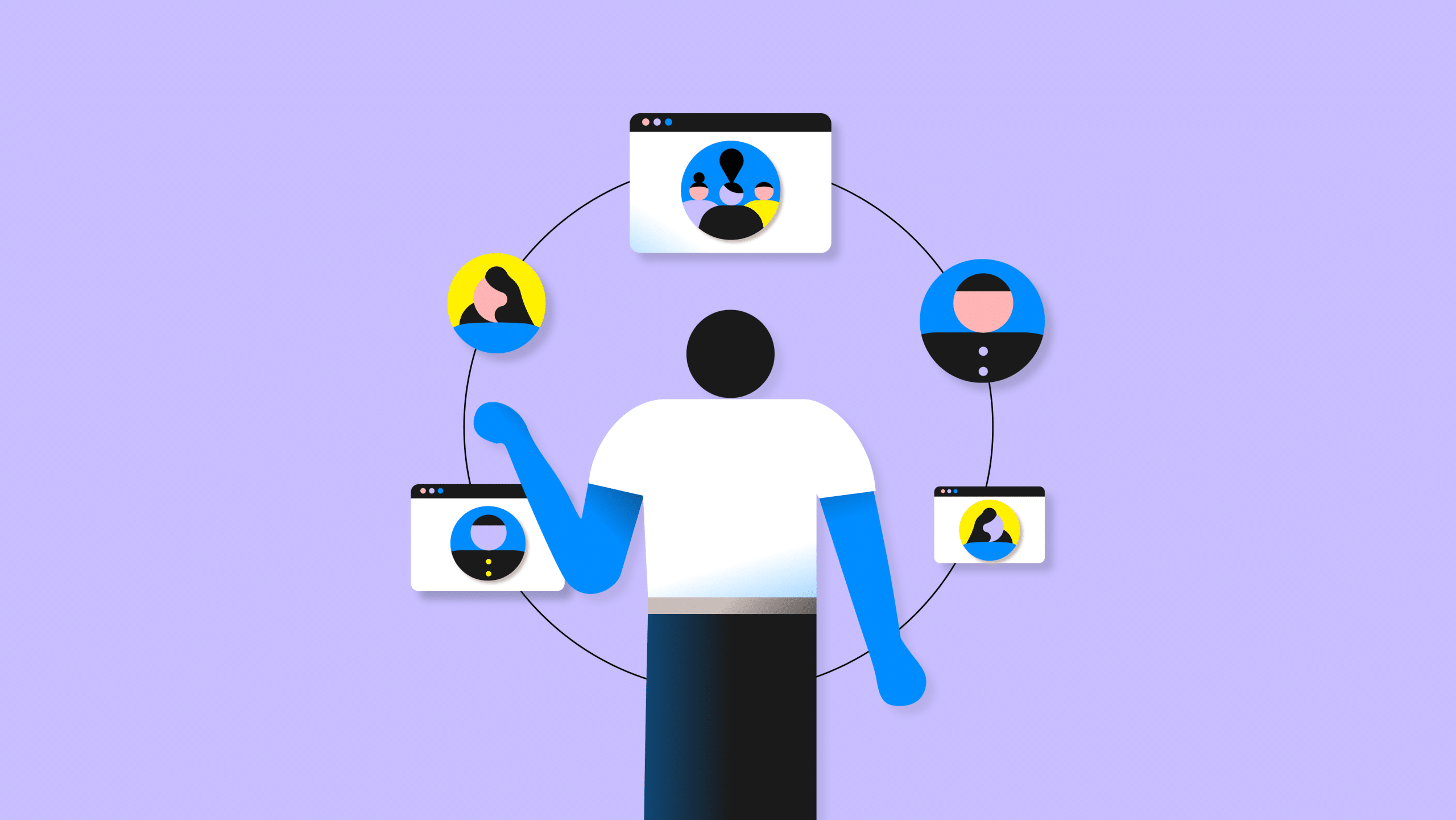
Audience engagement took on an entirely new meaning when virtual and hybrid events arrived during the pandemic. As in-person events regain dominance — 80.4% of organizers say in-person events are their organization’s most impactful marketing channel — and webinars continue to entice attendees, the question is: How do you keep participants engaged across all event formats?
Keeping attendees engaged throughout the entire event experience is key to achieving event success. According to 19% of the 1,757 event organizers surveyed for our State of in-person B2B conferences report, increasing attendee engagement is the highest priority for their company as they plan their next conference.
This guide will help you understand audience engagement strategies from every angle, how to implement engagement efforts, and how to measure engagement accurately. Read on to master audience engagement in 2024 and beyond.
What Is Audience Engagement?
Audience engagement measures whether and how attendees participate in your event and how pleased they are with the overall event experience. It is a multifaceted concept encompassing various forms of audience interaction, such as likes, shares, comments, and time spent on content. Audience engagement involves creating meaningful dialogues and relationships with the audience, fostering a sense of community and belonging around a brand or content.
Audience engagement is crucial for several reasons. It helps build brand loyalty and trust, as engaged users are likelier to develop a positive association with the brand. It also provides valuable insights into audience preferences and behaviors, allowing brands to tailor their content and strategies to meet their needs and expectations. High levels of engagement can lead to increased visibility, reach, and impact, ultimately driving brand growth and success.
Elements of Audience Engagement
- Interaction: The active audience participation through comments, likes, shares, and other forms of social media engagement
- Time Spent: The duration the audience consumes the content, indicating their interest and attention level
- Feedback: The opinions, suggestions, and thoughts the audience shares, providing insights into their preferences and expectations
- Community Building: Creating a supportive and inclusive environment where the audience feels valued and connected
Here are some specific KPIs you can measure as part of your audience engagement strategy:
- Sessions attended
- Duration of session attendance
- Meetings booked
- Meetings attended
- Poll participation
- Chat reactions (emojis)
- Connections made
- Social shares
- Chat participation
- Event app adoption
- Satisfaction surveys
An engaged attendee is a satisfied attendee, and the last thing you want is a group of attendees who experience your event passively. To avoid this, you must craft a spectacular event with exceptional content and clear opportunities for attendee engagement.
Get To Know Your Event Attendees
Before diving headfirst into audience engagement strategies, take one step back and ensure you fully understand your attendees. To understand how to engage an audience, you have to understand the audience itself.
First, get inside the minds of your attendees. Why are they coming to your event in the first place? Define the attendee’s goals and motivations. This will help you better anticipate attendee needs, create personalized experiences, and build successful events.
For example, at hybrid events, there are a few different ways that virtual attendees engage with events:
- Watching and listening: Online attendees are consuming video on a live stream
- Engaging with others online: Online attendees engage with other online attendees
- Engaging with everyone: Online attendees engage with anyone, whether online or in-person
Interestingly, in our Hybrid Event Trends Report, we found that while virtual attendees wanted to meet with in-person attendees, in-person attendees didn’t see value in speaking with virtual attendees. In fact, 58% of virtual attendees were willing to speak with any attendee, but 78% of in-person attendees only wanted to network with other in-person attendees.
The more you understand your audience, the better you’ll be able to plan for powerful brand activations, networking, and other engagement activities — and the more meaningful the data you collect will be.
How To Build Event Attendee Personas
One approach to getting to know your attendees is to define your attendee persona by using existing data. A buyer persona is a semi-fictional representation of your buyer based on actual customer data — whether from customer interviews, sales team interviews, market research, or another source. Buyer personas should detail demographics, psychographics, motivations and challenges, and more.
Here are some steps to get started:
- Build a targeted list of organizations and accounts that you’d like to engage at your events. In an account-based marketing strategy, this is usually referred to as your Target Account list or Tier 1 list.
- Decide on which data points you’ll use to create your buyer personas.
- Audit your event management platform to see if you can report on your defined data points. Your event software should let you collect professional titles, industries, company size, customers, prospects, countries, and more.
- Leverage the data to paint a picture of your event attendee personas.
Once you have the initial data points for your attendee profile, you can start brainstorming your engagement tactics.
One last thing: A buyer persona is different from an ICP (Ideal Customer Profile), which is used in B2B account-based marketing. An ICP includes a high-level list of characteristics for a business that would qualify them as a lead worth pursuing. That said, within the ideal customer profile, there are several different buyer personas.
Attendee intelligence is a critical component of driving engagement, and we recommend starting with attendee journey mapping so you can truly understand who is coming to your event.
Get a Better Picture of Your Attendees with Data
In addition to leveraging your event management software for the registration process, you should also investigate third-party integrations that can help level up your collection of attendee data. Here are some questions to consider:
- Which teams need visibility into event activities and data?
- What other technology is my organization using to capture customer and prospect data?
- What are the information gaps between my event tech stack and other software?
- What event data should be shared across my organization’s event technology stack?
- How do different event management platform integrations work?
- Is it easy to create and review reports and analytics?
How To Prioritize Attendees in the Registration Process
Designing an attendee-focused event with top engagement numbers starts with event registration. As you define different event personas, ask yourself the following questions to determine how to build your event registration:
- Should there be different ticket types or registration flows (i.e., for attendees, sponsors, exhibitors, vendors, speakers)?
- Will we offer paid or free tickets?
- Are we holding a one-day or multi-day event?
- Will we have multiple sessions, breakouts, or workshops?
- Is content going to be available on demand after the event?
- Will we serve meals at the event?
- Do we need home addresses to send swag boxes to attendees?
- Will we need clothing sizes for swag or gifts?
- Is there a need for captions or real-time translation?
Then, decide what data to collect during the registration process. Optimize the registration by offering specific ticket types and promo codes and using conditional questions to help website visitors select the event ticket that meets their needs.
How To Drive Audience Engagement Like a Pro
1. Define Your Metrics
The overwhelming majority (80%) of planners report that attendee engagement and satisfaction are the top KPIs used to measure virtual event success. But before deciding on engagement opportunities, you need to pinpoint what you want to measure and communicate those to everyone involved with the event.
Here are some important engagement metrics to consider for virtual, in-person, and hybrid events:
- Audience retention: How many people started a specific session or keynote versus how many remained at the end?
- Chat and poll participation: Were attendees asking questions during sessions? Were they responding to polls? Were they engaging with other attendees?
- Material downloads: If event sessions offered downloadable assets, how many attendees downloaded them?
- Session ratings: How satisfied were attendees with your content and the overall experience?
- Social media mentions: Who is talking about your event and what are they saying?
We’ll go into more detail about exactly how to measure these and what they mean for event success later in this article.
2. Create Meaningful Content
Content will always remain one of the most important audience engagement strategies, particularly for virtual and hybrid events. According to our Evolution of Events Report, the average virtual attendee only watches 68% of a virtual session that is 20 minutes or longer. For us, this means that the key to successful virtual or hybrid events is shorter sessions (goodbye 60-minute sessions).
But content length is only one part of fostering engagement. Understanding attendee personas and giving them what they want is the best way to achieve engagement success. Ask yourself questions to determine what your audience needs.
- What are your attendees’ challenges and pain points?
- How can your content answer their needs and help fix their problems?
- How can your content create conversations and dialogue?
- How can you craft content that resonates with live and virtual audiences?
Another simple way to assess what your audience wants is to ask them. Consider polling registrants about the kind and type of content they’d like to see, whether that’s at the point of registration or before the event sessions are locked in place.
3. Focus On User Experience
A virtual or hybrid event platform, aka venue, can be tricky for audiences to use the first time around. Pay extra attention to the user experience and choose a UX-friendly, easy-to-use event management platform. You can also take it one step further by providing attendees with an FAQ section and small video tutorials on navigating the platform and its features.
Another way to ensure attendees have a great experience and an easy time using your event platform is to offer a Technical Support Chat for each session. The easier it is for attendees to ask questions and get help, the happier and more engaged they’ll likely be.
To ensure you choose the right event partner, book demos with several event management software companies and ask plenty of questions about attendee engagement features. If they offer a free or limited trial, bring your event team in and play around with the software to ensure it offers everything you need to achieve event engagement success.
4. Let Attendees Choose Their Own Adventure
Let your audience choose their session track or recommend relevant sessions based on attendee’s job title or interests.
For instance, HubSpot’s INBOUND event offers tons of different content tracks and even goes so far as to color-coat the tracks for easy navigation and movement from session to session.
Not only do tracks let your audience feel in control and like you’re catering to their niche or needs, but it also ensures higher levels of engagement. You might also consider having one MC or moderator per track to create an even more fluid and consistent experience.
5. Use a Virtual Suggestion Box
Let the time leading up to your event be an opportunity for attendees to offer suggestions. Instead. of guessing about how to engage an audience, put a suggestion box on your website or send a survey with room for suggestions via email.
In truth, you should always be soliciting opinions and ideas from your event audience and customers. In our BizzaKnowledge Community, for example, we offer customers the opportunity to suggest ideas for our product team, which gives our customers a voice and brings fresh ideas to the table.

6. Mix It Up and Choose Shorter Sessions
Virtual attendees have a different attention span for event content than in-person attendees do. When you’re virtual, there are a million distractions on top of the event you’re attending. In fact, 66% of event organizers say that live sessions contribute to higher audience engagement and overall event success. But even today’s in-person audiences want shorter sessions and to skip the hours-long keynote address.
So how can you help attendees stay engaged? Shorter sessions!
In our Virtual Event Benchmark Report, we found that attendees watched 61% — or 37 minutes — of a 60-minute session. We recommend using this as a benchmark but also encourage you to fine-tune your session lengths by looking at past view rates of your sessions.
7. Design with Your Virtual Audience in Mind
As we fully embrace the hybrid era, it’s important to keep your virtual audience at the forefront of your event strategy. It’s easy to focus on the in-person audience, but hybrid events need to engage two distinct audiences. Although 60% of respondents to a Forrester study said creating virtual experiences that aren’t just another webinar is a challenge, you can’t just try and replicate the in-person experience for a virtual audience.
These audiences need to be treated equally, but not the same. But when 54% of event professionals struggle to predict the mix between virtual and in-person attendance, what can you do to ensure you’re delivering engaging and meaningful content and experiences for both audiences?
Make sure that cameras are set up for a high-quality virtual experience and that all of your tech works for all of your audiences. Additionally, leverage your event management technology to deliver the best attendee experience for both audiences. Whatever ideas you come up with for one audience, make sure you find a comparable experience for the other. That may mean weaving Q&A, polls, networking, and chats into the in-person experience or bringing fireside chats to the virtual audience.
How To Measure Audience Engagement
And now for what you’ve been waiting for: how to measure audience engagement at your next hybrid or virtual event.
1. Attendance and Registration Rates
Best for: In-person, Virtual, and Hybrid Events
The most fundamental measurement of engagement is whether an attendee shows up. Collect and analyze data for the following questions:
- Are attendees registering for multiple sessions or just one?
- Which sessions are the most and least popular?
- Are attendees tuning in live or on demand?
- How many attendees didn’t show up at all?
With these numbers in hand, you can start to evaluate whether your event schedule and content worked or whether you need to tweak your approach for the future. For example, if you had more virtual attendees register for shorter sessions than longer ones, you might want to adjust your schedule or content approach for future events.
Another benefit of assessing session registrations is that you can understand whether your marketing efforts are leading attendees to specific sessions or experiences.
2. Attendee Retention and View Duration Rates
Best for: In-person, Virtual, and Hybrid Events
In addition to event attendance, it’s vital to understand how many people stuck it out from start to finish in each of your sessions — or the event as a whole. High retention rates mean your content is resonating (and your engagement numbers are more likely to be high as well). If your retention rates are low, you may need to adjust your schedule, content, or engagement features.
For example, if 1,700 people registered and 1,200 logged in live, your attendance rate is roughly 70%. With these numbers, you can set benchmarks — and aspirational goals — for future events.
Additionally, when your content reaches your most valuable customers and prospects — and they’re watching your content from start to finish — it will be easier to engage them further with follow-up content and messaging.
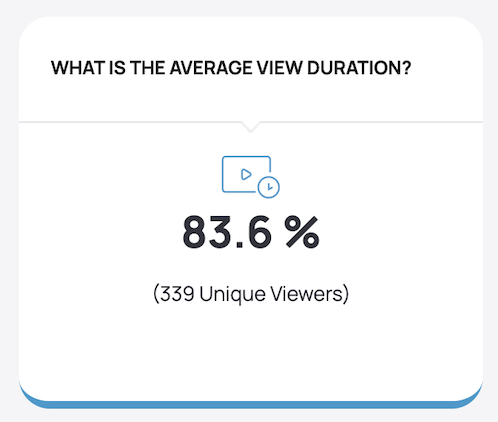
3. Session Engagement and Satisfaction Rates
Best for: In-person, Virtual, and Hybrid Events
Session engagement data helps you assess the success of your event content, particularly for virtual and hybrid events. Here are some questions to ask:
- Do your session topics, speakers, and panels resonate with your audience?
- Are virtual attendees using the chat, Q&A, and poll features during the sessions?
- Are people reacting to the content you’re presenting?
- Which presenter/speaker profiles are most liked or viewed?
It’s important to give attendees a way to react to and engage with event content. These engagement stats will allow you to identify the most successful content — as well as what missed the mark — so you can plan better for future events.
4. Social Media Activity
Best for: In-person, Virtual, and Hybrid Events
Speaking of content engagement, are you tracking attendee engagement and satisfaction on social media? For example:
- How many people are posting about your event?
- Is the event hashtag trending?
- How many times are your event posts being shared or retweeted?
- Which sessions are being talked about the most?
Asking these questions will help you understand how much social media activity is being generated from your event. Use social media monitoring and listening tools to keep track of all this activity and to paint an accurate picture of attendee engagement.
Additionally, tracking social media activity will leave you with a cache of user-generated content (UGC) to share in post-event communications and in advance of your next big event to get people hyped up.
5. Event App Downloads
Best for: In-person and Hybrid Events
On the one hand, downloading an event app is a simple task. On the other hand, you may need to craft an omnichannel event marketing strategy to encourage attendees to use the app. Once you have data on event app downloads, you can evaluate how effective your organization’s event app adoption campaign was and whether you’ve achieved your anticipated ROI.
For example, if attendees are downloading your app but not using it, you may need to do more UX work. If attendees aren’t downloading or using your app, you may need to reevaluate your tech investment or find an event management partner to help you work out the kinks.
6. Event App Engagement Rates
Best for: In-person and Hybrid Events
During the event itself, the event app will be a main source of attendee engagement. Because much of the event content is in the app, attendees should be using all of the app’s engagement features to maximize the event experience. Make sure your event management software offers a dashboard with event analytics that describe app performance and how attendees are engaging with your app.
7. Message Volume
Best for: In-person, Virtual, and Hybrid Events
Messages sent between attendees, vendors, and sponsors in your event app is another way to measure overall attendee engagement. You might need to reassess the UX within your event app or event management platform if you have low messaging rates.
8. Event Feedback Surveys
Best for: In-person, Virtual, and Hybrid Events
There’s no better way to assess how engaging and successful your event was than to ask! The moment the event is over, send your audience an event survey with questions that will give you valuable insights into what went right and wrong so you know what to replicate and what to avoid at your next event. Be sure to send your feedback surveys out as soon as possible so that the experience is top of mind.
Want to know what to ask? Read “37 Event Survey Questions You Need to Ask For the Best Insights”
9. Live Polling Response Rate
Best for: In-person, Virtual, and Hybrid Events
Polls can boost attendee engagement and satisfaction, particularly for virtual events. Plan your polls and ensure they’re tied closely to your session content — and don’t use too many polls in a single session. You don’t want your polls to backfire!
10. New vs. Returning Attendees
Best for: In-person, Virtual, and Hybrid Events
Do you host a lot of events? Just a few? Even if you only have an annual event, it’s important to measure new versus returning attendees. This information will let you know who your most loyal event attendees are and who is new to your event ecosystem.
For example, new attendees might need more assistance using the app or event management software (aka the venue) whereas returning attendees may just need information about updated features. This information will help you engage with attendees before, during, and after in a more personalized way — a great opportunity for boosting engagement and satisfaction numbers!
Leveraging Bizzabo’s Klik SmartBadge™ for Enhanced Audience Engagement
Understanding and enhancing audience engagement is paramount in today’s dynamic event landscape. Enter Bizzabo’s Klik SmartBadge™, a revolutionary tool that measures and amplifies audience engagement.
Leverage Data-driven Insights with Klik
- Location tracking: Organizers can optimize venue layouts by understanding where attendees spend their time, ensuring popular sessions or exhibitors are easily accessible.
- Session attendance: Real-time data on session attendance helps make on-the-spot decisions, like opening overflow rooms for popular sessions.
- Session scoring: Feedback is gold. Organizers can identify star speakers or topics by analyzing session scores and replicate their success in future events.
- Connections: The ease of “Kliking” badges to exchange contact info encourages networking, providing insights into collaboration and partnership opportunities.
- Exhibitor data: Understanding which exhibitors are drawing crowds and which aren’t can help in booth placements and sponsorship packages.
- Touchpoints: These interactive zones, where attendees can download content or engage in activities, provide data on popular topics or areas of interest.

Boost Engagement with Klik
- Light cues: Visual cues, like badge lights, can signal session starts, networking opportunities, or even fun, gamified elements.
- Simplified contact exchange: The hassle-free “Klik” to exchange contact info removes barriers to networking, encouraging more connections.
- Interactive exhibitor engagement: Exhibitors can use the badges to easily capture leads, making the process seamless and encouraging more booth visits.
Incorporating Bizzabo’s Klik SmartBadge™ into your event strategy ensures you’re not just collecting data but actively using it to enhance the attendee experience, leading to more successful and engaging events.
6 Ways Event Management Software Can Boost Event Engagement
1. Messaging
Messaging is one of the best engagement tools for attendee networking. The more often attendees message each other, the higher the event engagement rate. Ensure attendees know that messaging is available before the event start date so they can explore attendee profiles and reach out to relevant connections when the time is right.
2. Push Notifications
Where direct messaging encourages interactions between attendees, push notifications increase engagement between the organizer and the attendees. These messages are usually sent out to all attendees at the same time to inform them of a schedule change, offer complementary content during a session, or share other important information.
Designing push notifications that solicit a response from attendees is a good way to increase engagement. Push notifications are helpful for virtual attendees because they’re not in the venue itself, so they may need additional nudges to show up to sessions or participate.
3. Personalized Agenda
Advanced hybrid and virtual event software allows attendees to create their schedules by starring the sessions that they would like to attend. Also, your event management software should let you automatically suggest session tracks for attendees based on their background, title, or interests. Assuming your event management software is capable, the platform should be able to track the number of times a particular session has been added to attendee schedules, giving insight into which sessions were most popular.
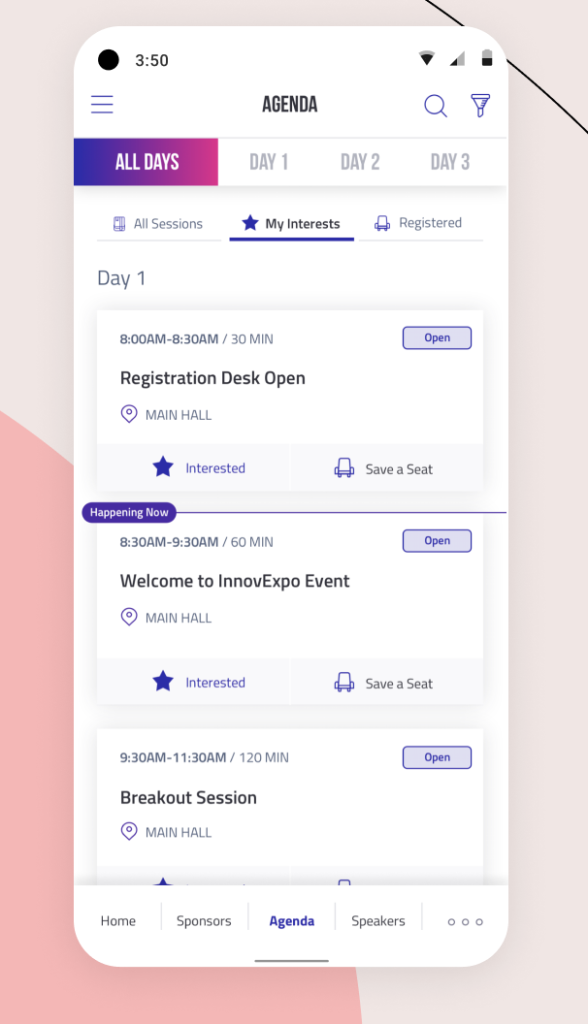
4. Session Reviews
One of the best ways to measure attendee engagement levels is to enable session reviews. Ideally, attendees should be able to review sessions on a scale (e.g., 1-5 stars) and through open-ended survey questions. This way, attendees aren’t limited in the type of feedback they want to give.
Gathering as much session feedback as possible — both qualitative and quantitative — will allow you to thoroughly understand attendee engagement and satisfaction.
5. Event Polls
In addition to session ratings, polls allow event organizers to collect relevant data before, during, and after the event. Most Importantly, polls allow you to collect on-the-spot data about what an attendee is feeling. Polls offer a structured way to collect data for different use cases, including the following:
- Attendee communication preferences
- Event satisfaction
- Event engagement
- Session duration preferences
- Session interest levels
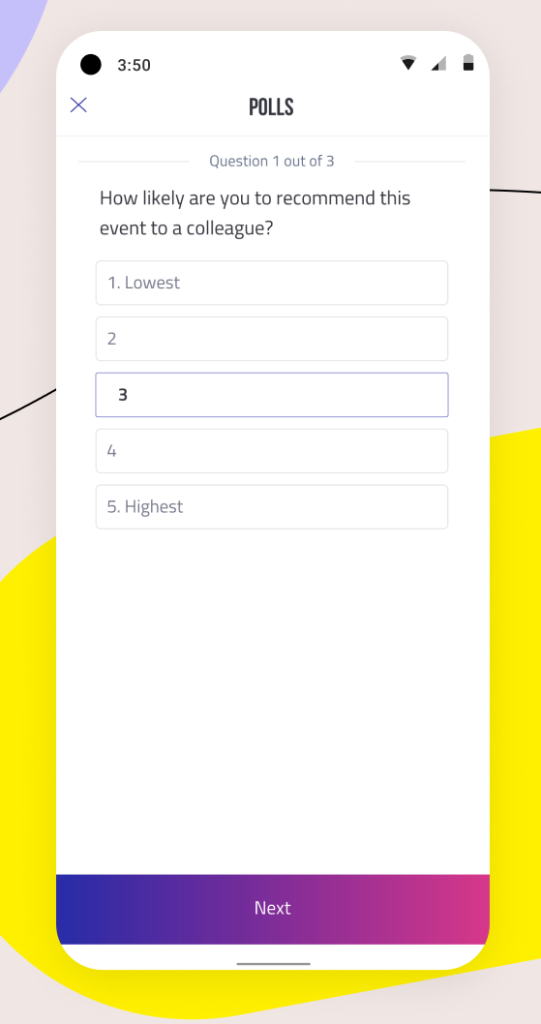
6. Live Q&A
We already mentioned the importance of Q&A sessions through chat rooms, but it’s worth repeating. Allowing attendees to pose questions to the speakers and discuss amongst themselves is key to driving engagement, and the best event software will undoubtedly include this feature.
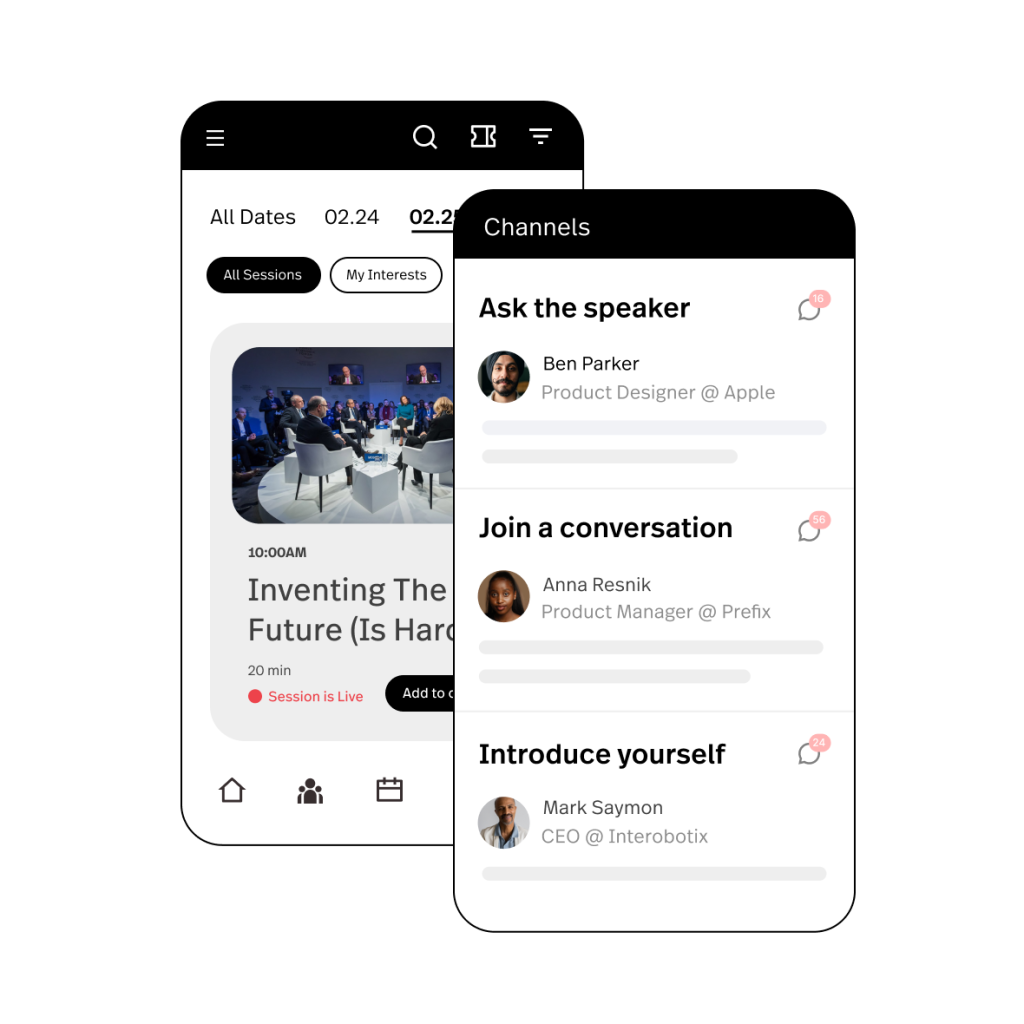
How To Use Generative AI To Boost Attendee Engagement at Your Next Event
Generative AI, with its ability to create content, simulate user interactions, and analyze data, has emerged as a revolutionary tool for event planners seeking to boost engagement levels at their events. This advanced technology can be instrumental in creating personalized and immersive experiences, fostering interaction, and gathering insights to refine event strategies. Here are some ideas to add to your audience engagement strategies.
Personalized Experiences
You can use generative AI to analyze attendee data to create highly personalized experiences. By understanding individual preferences, needs, and behaviors, AI can help curate content, recommend sessions, and facilitate networking opportunities that resonate with each attendee, thereby increasing satisfaction and engagement levels.
Interactive Content Creation
Generative AI can produce interactive and dynamic content such as quizzes, polls, and games to captivate the audience’s attention. This interactive content not only adds an element of fun and excitement to the event but also encourages participation and dialogue among attendees, fostering a sense of community and connection.
Real-time Insights and Adaptation
AI can process and analyze real-time data to gauge audience reactions and engagement levels during the event. This enables event planners to adjust the schedule, content, or interaction methods immediately, ensuring optimal engagement and effectively addressing attendee needs and expectations.
Enhanced Communication
Generative AI can automate and enhance communication through chatbots and virtual assistants, providing instant responses to attendee queries, concerns, and feedback. This immediate and personalized interaction enhances the attendee experience and allows event planners to address issues proactively, maintaining a positive event atmosphere.
Post-Event Analysis
After the event concludes, generative AI can assist in analyzing feedback and engagement data to identify areas of success and opportunities for improvement. This analysis is crucial for refining future event strategies, improving engagement, and ensuring events’ continuous evolution and success.
Ultimately, generative AI is a transformative tool that empowers event planners to elevate engagement by delivering personalized, interactive, and responsive experiences. By harnessing the capabilities of AI, event planners can create events that are not only memorable and enjoyable but also highly attuned to the needs and desires of the attendees. The integration of generative AI in event planning signifies a move towards more intelligent, adaptive, and user-centric events, promising a future of unparalleled engagement and connection.
Key Takeaways: How To Enhance Your Audience Engagement Strategy
Attendee engagement and event experience are key to your event success. As a recap, here are some of the most valuable points that we’ve discussed:
- Get to know who your attendee personas are so you can choose the best content and deploy engagement tools with the greatest ROI.
- If you’re going hybrid, remember to consider both audiences and how engagement strategies will differ.
- Leverage event management software and apps to foster engagement, boost attendee satisfaction, and evaluate event success.
- Assign specific metrics to your engagement goals so you can make data-informed decisions about future event tactics.
As virtual and hybrid events become the rule, rather than the exception, you must fine-tune your event strategy every quarter — if not more frequently. We hope this guide was useful and, as you plan your next virtual or hybrid event, will help you meet and exceed your goals.
Editor’s Note: This post was originally published in January 2019 and has been updated for relevance.



